
The Upper Town has always had a more aristocratic feel than the medieval, commercial streets of the Lower Town. With broad boulevards, big marble buildings, palaces, museums, and so many things called “royal,” it also seems much newer and a bit more sterile. But the Upper Town has plenty to offer.
Use this walk to get acquainted with this less-touristed part of town, sample some world-class museums, see the palace, explore art galleries, and get the lay of the land from a panoramic viewpoint. The tour starts a half-block from the one essential art sight in town, the complex that holds the Royal Museums of Fine Arts of Belgium (Ancient Art and Fin de Siècle) and the Magritte Museum. Consider a visit while you’re here (see next chapter). The Musical Instruments Museum is also in the neighborhood.
Length of This Walk: Allow 1.5 hours.
Getting There: The walk begins at Place Royale/Koningsplein in the Upper Town. You have several ways to get there:
1. From the Grand Place, walk uphill for 15 minutes (follow your map).
2. Catch a taxi (figure €6 from the Bourse).
3. From Rue du Lombard south of the Grand Place, take bus #95, which leaves every few minutes for Place Royale (bus signs call it Royale/Koning; buy €2.50 ticket from driver, validate in machine).
4. Hop off here during a hop-on, hop-off bus tour.
Route Overview: From Place Royale, walk south along the ridge. On the way, pop in to a stained-glass-filled Gothic church, then continue on to reach the towering Palace of Justice, which has the best view of the city. Backtrack a bit and descend through the well-worn tapestry of the Sablon Quarter’s antiques stores, art galleries, and cafés, ending down to the Manneken-Pis at the foot of the hill.
Starring: Brussels’ genteel Upper Town, with its best museums, top views, and a bit of personality poking out from behind its stuffy veneer.
 Place Royale (Koningsplein)
Place Royale (Koningsplein)At the crest of the hill sits Place Royale, encircled by cars and trams and enclosed by white Neoclassical buildings forming a mirror image across a cobblestone square. A big, green statue of a horseman stands in the center.
The statue depicts the local hero, Godfrey de Bouillon, who led the First Crusade (in 1096). The ultimate Catholic knight, he rides forward with his flag, gazing down on the Town Hall spire. If Godfrey turned and looked left down Rue de la Régence, he’d see the domed Palace of Justice at the end of the boulevard. Over his right shoulder, just outside the square, is the Royal Palace, the king’s residence.
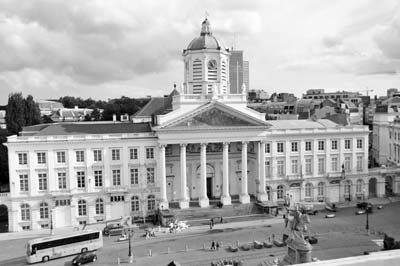
In the 1870s, as Belgium exerted itself to industrialize and modernize, this tight ensemble of planned buildings and squares was rebuilt as a sign that Brussels had arrived as a world capital. Broad vistas down wide boulevards end at gleaming white, Greek-columned monuments—this look was all the rage, seen in Paris, London, Washington, DC...and here.
The cupola of the Church of St. Jacques sur Coudenberg—the central portion of the square’s ring of buildings—makes the church look more like a bank building. But St. Jacques’ church goes back much further than this building (from 1787); the original was built here in the 13th century near a 12th-century castle. Nobles chose to build their mansions in the neighborhood—and, later, so did the king. And when locals stand here, they remember that it was on the porch of this building, on July 21, 1931, that their first king took the oath that established modern Belgium.
The square has several worthwhile museums: the Royal Museums of Fine Arts of Belgium (main entrance a half-block to the right) and the associated Magritte Museum (facing the crusader statue), and the Musical Instruments Museum, straight downhill from the square—if Godfrey spurred his horse straight ahead, he’d pass it on his right. It’s housed in an early 20th-century iron-and-glass former department store. Its Art Nouveau facade was a deliberate attempt to get beyond the retro-looking Greek columns and domes of the Place Royale. Even if you don’t visit the Musical Instruments Museum, you can ride the elevator up to the museum café for a superb Lower Town view.
• Before heading south, exit Place Royale on the north side (to the left as you face Godfrey), which opens up to the large, tree-lined...
 Parc de Bruxelles
Parc de BruxellesCopying Versailles, the Habsburg empress Maria Theresa of Austria (Marie-Antoinette’s mom) had this symmetrical park laid out in 1776, when she ruled (but never visited) the city. This is just one of many large parks in Brussels, which started with an awareness of the importance of city planning.
At the far (north) end of the park (directly opposite the Royal Palace, no need to actually walk there) is the Parliament building. Which parliament? The city hosts several: the European Parliament, the Belgian Parliament, and several local, city-council-type parliaments. This is the Belgian Parliament, seen on nightly newscasts as a backdrop for talking heads and politicians.
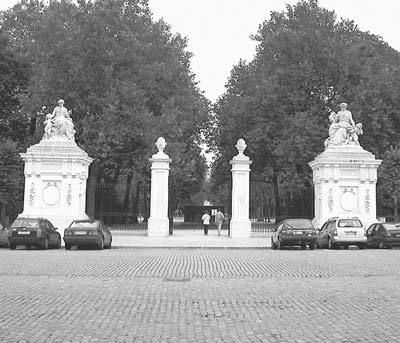
In 1830, Belgian patriots rose up and converged on the park, where they attacked the troops of the Dutch king. This was the first blow in a short, almost bloodless revolution that drove out the foreign-born king and gave the Belgians independence...and a different foreign-born king.
• The long building facing the park is the...
 Royal Palace (Palais Royale)
Royal Palace (Palais Royale)Belgium struck out twice trying to convince someone to be its new king. Finally, Leopold I (r. 1831-1865), a nobleman from Germany, agreed to become “King of the Belgians.” Leopold was a steadying influence as the country modernized. His son rebuilt this palace—near the site of earlier palaces, dating back to the 10th century—by linking a row of townhouse mansions with a unifying facade (around 1870).

Leopold’s great-great-great-grandnephew, King Albert II, today uses the palace as an office. (His head is on Belgium’s euro coins.) Albert and his wife, Queen Paola, live in a palace north of here (near the Atomium) and on the French Riviera. If the Belgian flag (black-yellow-red) is flying from the palace, the king is somewhere in Belgium.
Albert II (born 1932) is a figurehead king, as in many European democracies, but he serves an important function as a common bond between bickering Flemish and Walloon citizens. His son, Prince Philippe, is slated to succeed him, though Philippe—awkward and standoffish—is not as popular as his wife, Mathilde, also a Belgian native. Their daughter, Elisabeth, born in 2001, will someday become the first Belgian queen.
The bulk of the palace is off-limits to tourists except from late July through early September (see www.opt.be for the latest schedule; gardens open April-May). The adjacent BELvue Museum has an impressive exhibit on Belgian history and the royal family, but I’d skip the ho-hum Coudenberg Palace ruins (same entry for both).
• Return to Place Royale, then continue south along Rue de la Régence, noticing the main entrance to the Royal Museums of Fine Arts of Belgium complex. Just past the museums, on the right, you’ll see a...
 Sculpture Garden (Jardin de Sculpture)
Sculpture Garden (Jardin de Sculpture)This pleasant public garden features a statue by Rodin’s contemporary, Aristide Maillol, a master of the female form. In The River (1938-1943), the moving water is personified as a woman sprawled on her side (and looking terrified, or at least stressed—the statue was originally conceived to represent a victim of war). The wave-like figure teeters on the edge of a pool of water, about to pour in. Or is she just washing her hair? Another copy of this bronze statue sprawls near a pool in the courtyard of New York’s Museum of Modern Art.

The garden looks like a great way to descend into the Sablon Quarter, but the gates at the bottom are often locked.
• About 100 yards farther along Rue de la Régence, you reach the top of the Sablon neighborhood, dominated by the...
 Notre-Dame du Sablon Church
Notre-Dame du Sablon ChurchThe round, rose, stained-glass windows in the clerestory of this 14th-century Flamboyant Gothic church are nice by day, but are thrilling at night, when the church is lit from inside and glows like a lantern, enjoyed by locals at the cafés in the surrounding square.
Step inside (free, open daily 8:00-18:00). An artistically carved pulpit stands midway up the nave. The stained-glass windows in the nave (which date from the 19th and 20th centuries) are notable for their symmetry—rows of saints in Gothic niches topped by coats of arms. The glorious apse behind the altar—bathed in colorful light from original 15th-century windows—is what Gothic is all about. The left transept has relics of Karl I, the last Habsburg emperor (1887-1922), who was deposed when Austria became a republic after World War I. Karl’s Catholic devotion was legendary, and he was beatified in 2004. Many devoted people pray here, inspired by his patient suffering in exile.
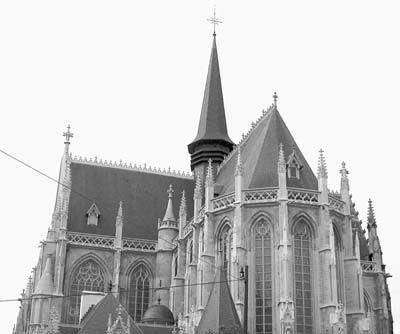
Next to the altar, see a small wooden statue of Mary dressed in white with a lace veil. This is a copy, made after iconoclastic Protestant vandals destroyed the original. The original statue was thought to have had miraculous powers that saved the town from plagues. In 1348, when the statue was in Antwerp, it spoke to a godly woman named Beatrix, prompting her to snatch Mary, board a boat, and steal the statue away from Antwerp. (That’s why the church is decorated with several images of boats, including the small wooden boat high up in the right transept.) When the citizens of Antwerp tried to stop Beatrix, the Mary statue froze them in their tracks.
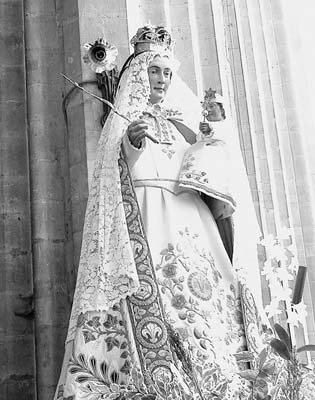
When Beatrix and the statue arrived here, the Bruxelloise welcomed Mary with a joyous parade. Not long after, this large church was erected in her honor. Every summer, in Brussels’ famous Ommegang procession, locals in tights and flamboyant costumes re-create the joyous arrival with colorful banners and large puppets. Imagine the scene as they carry Mary from here through the city streets to the parade’s climax on the Grand Place.
• We’ll return to the colorful Place du grand Sablon (below the church) later in the walk. For now, head to the other side of Rue de la Régence from the church, where you’ll find a leafy, fenced-off garden called the...
 Place du Petit Sablon
Place du Petit Sablon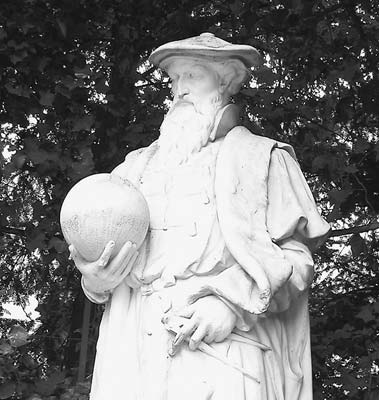
Step into this charming little park, a pleasant refuge from the busy street and part of why this neighborhood is considered so livable. Its central fountain, a fine example of 19th-century Romanticism, honors two local nobles who were executed because they promoted tolerance during the Inquisition. Good friends, one Catholic and the other Protestant, they were beheaded on the Grand Place in 1568.
Check out the other statues. The 48 small statues atop the wrought-iron fence represent the craftsman guilds—weavers, brewers, and butchers—of 16th-century Brussels. And inside the garden, the 10 large statues represent hometown thinkers of the 16th century—a time of great intellectual accomplishments in Brussels. Gerardus Mercator (1512-1594), the Belgian mapmaker who devised a way to more accurately show the spherical Earth on a flat surface, holds a globe.
This collection of statues functions as a reminder that, even though Belgium was never a great power, Belgians have much to be proud of as a people. From here, look back at the church and enjoy its flamboyant late Gothic lines.
• We’ll visit the Sablon neighborhood below the church later, but before losing elevation, let’s continue along Rue de la Régence, passing on the left the Music Academy and Brussels’ main synagogue—its sidewalk fortified with concrete posts to keep car bombs at a distance—and an ugly, prefab, concrete Lego-style building of the 1960s on the right, before reaching the long-scaffolded...
 Palace of Justice (Palais de Justice)
Palace of Justice (Palais de Justice)This domed mountain of marble sits on the edge of the Upper Town ridge, dominating the Brussels skyline. Built in wedding-cake layers of Greek columns, it’s topped with a dome taller than St. Peter’s in Rome, rising 340 feet. Covering more than six acres, it’s the size of a baseball stadium. Extending seven floors underground, it’s so big it has its own postal code.

The palace was built in the time of King Leopold II (son of Leo I, r. 1865-1909) and epitomizes the brassy, showy grandeur of his reign. Leopold became obscenely wealthy by turning Africa’s Congo region—80 times the size of Belgium—into his personal colony. Whip-wielding Belgian masters forced Congolese slaves to tend lucrative rubber plantations, exploiting the new craze for car tires. Leopold spent much of this wealth expanding and beautifying the city of Brussels.
The building, (which stands on the historic site of the town gallows) serves as a Hall of Justice, where major court cases are tried. If you pop in to the lobby, you may see lawyers in black robes buzzing about.
Notice the rack of city bikes. Like many other European cities, Brussels subsidizes a public-bike system. The program, called “Villo,” lets locals use bikes scattered all over town (note the map here) for a token €1 per hour. You can pick up a bike in one part of town and drop it off anywhere else. But the scheme doesn’t always work as well as intended: These bike racks are often empty, since this is a popular place to grab a bike for the easy ride back down to the Lower Town.
• One of the best views of Brussels is immediately to the right of the Palace of Justice.
 Viewpoint from Place Poelaert
Viewpoint from Place PoelaertYou’re standing 200 feet above the former Senne River Valley. Gazing west over the Lower Town, pan the valley from right (north) to left:
Near you is the stubby clock tower of the Minimen Church (which hosts lunchtime concerts in the summer). To the left of that, in the distance past a tall square skyscraper, is the lacy, white Town Hall spire (marking the Grand Place).
Twinkling in the far distance, six miles away, you can see one of the city’s landmarks, the Atomium. (No doubt, someone atop it is looking back at you.) The Atomium’s nine shiny steel balls form the shape of an iron molecule that’s the size of the Palace of Justice behind you. Built for the 1958 World’s Fair, it’s now a middle-aged symbol of the dawn of the Atomic Era.
Next (closer to you) rises the black clock tower of the Notre-Dame de la Chapelle church, the city’s oldest (from 1134, with a tower that starts Gothic and ends Baroque). On the distant horizon, see four boxy skyscrapers, part of the residential sprawl of this city of over a million, which now covers 62 square miles. Breaking the horizon to the left is a green dome, which belongs to the Basilica of Koekelberg (fourth-biggest in the world). And finally (panning quickly to the left), you see a black glass skyscraper marking the Midi/Zuid/South train station, where you can catch special high-speed train lines, such as the Eurostar, to London.
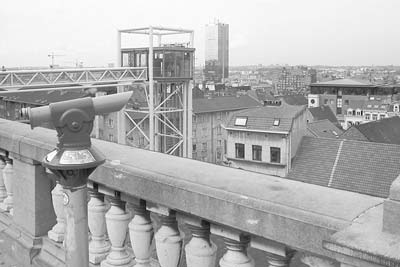
At your feet lies the Marolles neighborhood. Once a funky, poor place where locals developed their own quirky dialogue, today it can be either seedy or colorful, depending on the time of day and your perception. The area is famous for its sprawling flea market (daily 7:00-14:00, best on weekends). Two of the streets just below you—Rue Haute/Hoogstraat and Rue Blaes/Blaesstraat—are lined with secondhand shops. An elevator (free, daily 6:00-23:00) connects Place Poelaert with the Marolles neighborhood, which is worth a 10-minute detour to descend to the café-lined square. People who brake for garage sales may want to cut out of this walk early and head to the Marolles from here.
Gazing off into the distance to the far left (south), you can’t quite see the suburb of Waterloo, 10 miles away. But try to imagine it, because it was there that the tide of European history turned. On the morning of June 18, 1815, Napoleon waited two hours for the ground to dry before sending his troops into battle. That time lag may have cost him the battle. His 72,000 soldiers could have defeated Wellington’s 68,000, but the two-hour delay was just enough time for Wellington’s reinforcements to arrive—45,000 Prussian troops. Napoleon had to surrender, his rule of Europe ended, and Belgium was placed under a Dutch king—until the Belgians won their independence in the 1830 revolution.
Behind you, in Place Poelaert, is a memorial to the two World Wars, both of which slashed through Belgium with deadly force.
• Backtrack east, descending to Place du Grand Sablon by walking down Rue Ernest Allard. Passing lots of antiques shops and galleries, you’ll eventually reach a square below the Notre-Dame du Sablon Church. (For a light, healthy, and characteristic meal, Le Pain Quotidien—just off the square at Rue des Sablons 11—offers a fine value with delightful seating and baked goods right out of the oven.)
 Place du Grand Sablon
Place du Grand SablonThe Sablon neighborhood features cafés and restaurants, antiques stores, and art galleries. Every weekend, there’s an antiques market on the square. On warm summer evenings, the square sparks magic, as sophisticated locals sip apéritifs at the café tables, admiring the church’s glowing stained glass. Chocolatier Wittamer (on the far side of the square, at #6) often has elaborate window displays. And at the bottom of the square is the shop of the innovative Pierre Marcolini—who was declared the world’s top chocolatier—with a tempting buffet upstairs.

• Sloping Place du Grand Sablon funnels downhill into the pedestrian-only street called Rue de Rollebeek. With a few surviving buildings, it gives a little sense of the city before its 1695 bombardment (which leveled the center of town). It leads you past fun shops to the busy Boulevard de l’Empereur. To the right on the boulevard, just past the gas station, is the...
 Tour d’Angle
Tour d’AngleThe “Corner Tower” is a rare surviving section of Brussels’ medieval city wall. It stood over one of seven gates along the 2.5-mile-long wall that enclosed one of Europe’s great cities—13th-century Brussels. Notice the slash through the city here that marks where underground train lines connect the Central Station (to your right) and the South Station (to your left). Six tracks under you are kept busy with about a thousand trains a day. This ambitious bit of city infrastructure was a project started in 1902 and not finished until 1952—two occupations by Germany slowed things down.
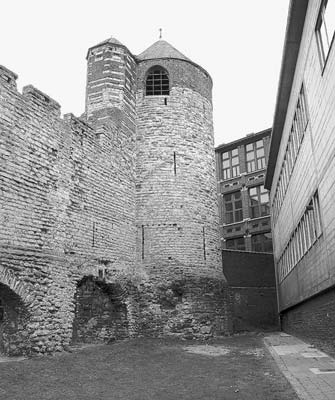
• Cross the street, head right, and take first left which leads downhill to a pleasant square at the T-intersection.
 Place Vieille Halle aux Blés
Place Vieille Halle aux BlésDo a 360-degree sweep from the center of this charming little square, circled by nice apartments. Imagine what a delight it would be to call this neighborhood home. Twenty years ago, this was a derelict slum—a good reason why Brussels was famous as a fine place to work but a lousy place to live. People were moving out, leaving the down-and-out downtown. But in 1989 Brussels became its own political region and got its own government. Since then, its policy has been to revitalize the center of town; tearing down homes to build office space is no longer allowed. Consequently, new construction is reserved for residences and people are moving into the area again. As in so many European cities, government policies are spurring the revitalization of old town centers.
• Your walk is finished. From here, to reach the Manneken-Pis and the Grand Place, just follow the signs.